Invented by Peter D. Harney, deceased, Vector Objects LLC
Multicomponent nucleic acids constructs are complex structures that contain multiple genes or genetic elements. These constructs are used in a variety of applications, including gene therapy, gene editing, and synthetic biology. They are also used in research to study the function of genes and their interactions with other genes and proteins.
The preparation of multicomponent nucleic acids constructs can be a challenging and time-consuming process. It requires the use of specialized techniques and equipment, as well as a deep understanding of molecular biology and genetics. As a result, many researchers and companies are turning to methods and kits that simplify and streamline the process.
There are several different methods and kits available for the preparation of multicomponent nucleic acids constructs. These include traditional cloning techniques, such as restriction enzyme digestion and ligation, as well as newer methods such as Gibson assembly and Golden Gate assembly.
Traditional cloning techniques are well-established and widely used in molecular biology. However, they can be time-consuming and require multiple steps. Gibson assembly and Golden Gate assembly are newer methods that offer faster and more efficient assembly of multicomponent nucleic acids constructs.
Gibson assembly is a method that uses a combination of exonuclease and DNA polymerase to join overlapping DNA fragments. This method can be used to assemble up to 10 fragments in a single reaction, making it ideal for the preparation of complex multicomponent nucleic acids constructs.
Golden Gate assembly is a method that uses type IIS restriction enzymes to cut DNA at specific sites. This allows for the assembly of multiple DNA fragments in a single reaction. Golden Gate assembly is highly efficient and can be used to assemble up to 20 fragments in a single reaction.
The market for methods and kits for the preparation of multicomponent nucleic acids constructs is expected to continue to grow in the coming years. This is due to the increasing demand for more efficient and accurate methods of gene editing and gene therapy, as well as the growing interest in synthetic biology and genetic engineering.
Companies that offer methods and kits for the preparation of multicomponent nucleic acids constructs are well-positioned to capitalize on this growing market. They can offer researchers and companies a range of options for assembling complex genetic constructs, and help to accelerate the development of new gene therapies and synthetic biology applications.
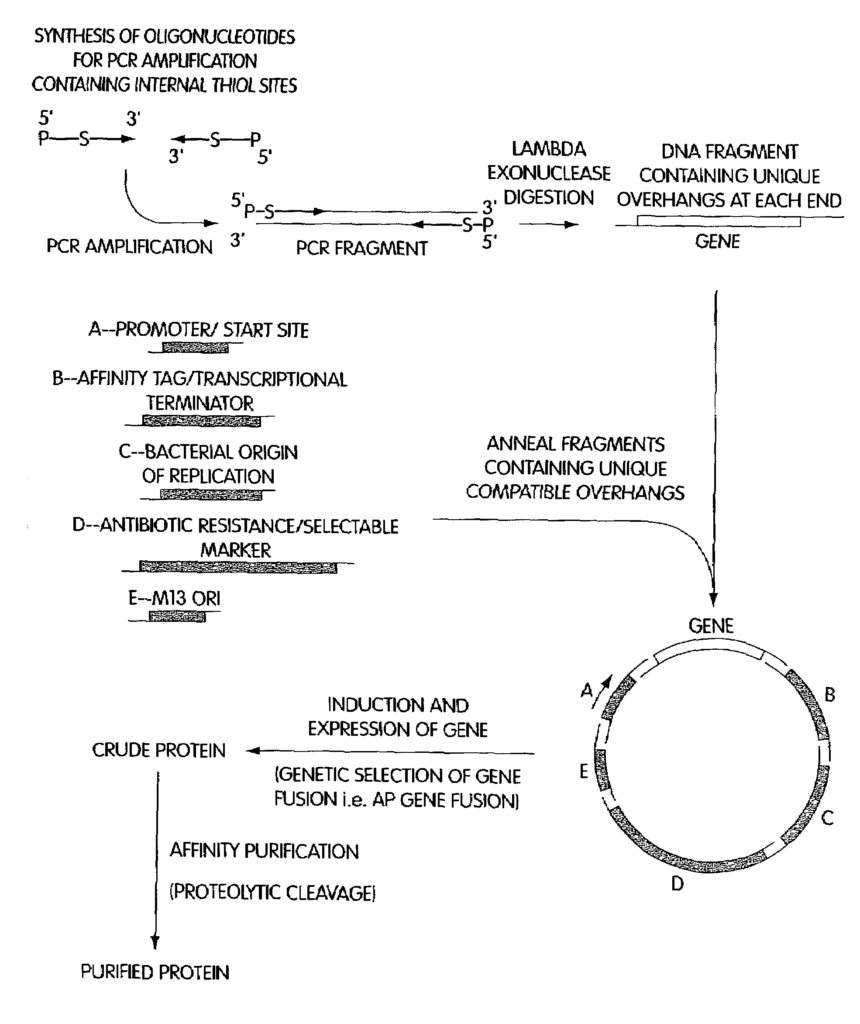
The Vector Objects LLC invention works as follows
The invention is a method for linking nucleic acids in a predetermined sequence to create a multi-component nucleic construct. It is highly efficient, cost effective, and rapid. The invention also provides nucleic acids, where each nucleic component consists of a double-stranded nucleic molecule with at least one single-stranded 5? The invention further provides nucleic acid components, each of which comprises a double stranded nucleic acid molecule having at least one single stranded 5? Terminal sequence. The terminal sequence has sufficient complementarity with a terminal nucleic sequence of a nucleic component that is separate or a sequence of a linking nucleic acids molecule to allow specific annealing and linkage of components in an ordered manner. Kits that contain reagents necessary to practice the method are also provided.
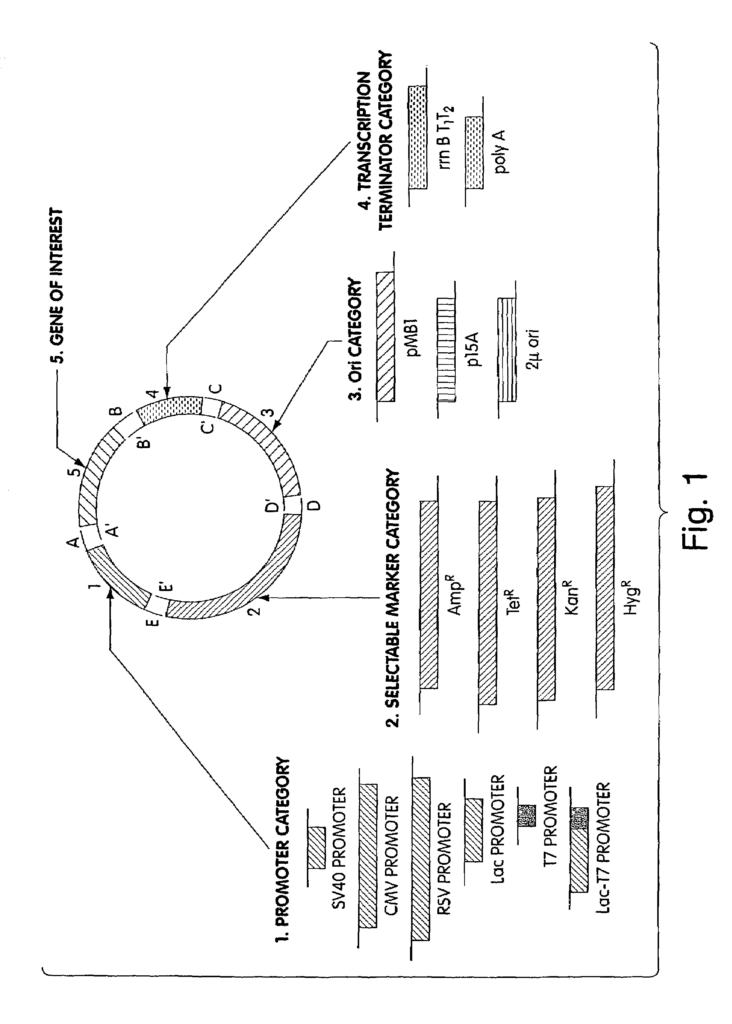
Background for Methods and kits for the preparation of multicomponent nucleic acids constructs
The essence of recombinant-DNA technology is the joining together of two or more segments of DNA in order to create a single DNA molecular capable of self-replication within a host. In order to create hybrid DNA molecules, the DNA sequences that are of interest must be cloned into a cloning vector. This can include a gene insert or gene fragment containing synthetic or natural genes. The cloning vector contains all the components necessary for the replication of the insert in a host cell compatible with the insert, such as a promoter sequence and termination sequence. DNA insert sequences are derived from any organism and can be isolated from the genome or mRNA. They may also be obtained from previously cloned sequences. The DNA insert sequences may also be synthesized.
Insertion can be achieved by using a variety of techniques. Restriction enzymes are the most common method. The restriction enzyme recognition sites are cleaved using a restriction enzyme. Next, the alkaline-phosphatase is used to remove the terminal phosphates from the vector or DNA insert. Finally, the DNA sequence is inserted at compatible sites in the vector during the ligation. The restriction enzyme in a vector pre-assembled must be compatible to a restriction site in the DNA sequence.
Alternatively, DNA of interest can also be modified to obtain compatible restrictions sites by filling out cohesive ends, as appropriate, or ligating an appropriate oligonucleotide, which can then be cleaved with the restriction enzyme.
Conventional cloning can be time-consuming and involve many subcloning stages. There is a need to develop a rapid and simple method of identifying and synthesizing the optimal construct for a specific application.
This invention relates to methods of preparing multicomponent nucleic acids constructs. The invention’s method can be used to express synthetic or naturally occurring genes and gene fragments. The invention includes integral vector elements that can be either selected specifically or varied to create a set of vectors, from which the optimal configurations or screeners can be chosen. These integral vectors include vector backbones, which don’t directly affect the expression of the insert gene, or fragment of a gene, as well as insert modifying elements that alter the expression, or form, of the insert encoded gene product. GEOS is a system that allows for rapid and flexible assembly specific multicomponent nucleic acids constructs. GEOS has a wide range of applications, from simple circular expression vectors up to complex linar assembly that function as small chromosomes. Various applications of GEOS are discussed below in detail and others will be obvious to the skilled artisan.
The invention also provides a method for linking the vector elements nucleic acids in a predetermined sequence so as to create a multi-component nucleic construct.
The GEOS method includes:
(a), providing the nucleic acids components to be assembled into constructs, each component containing a double-stranded nucleic molecule with at least one single-stranded 5? “(a) providing the nucleic acid components to be assembled into the construct, each component comprising a double stranded nucleic acid molecule having at least one single stranded 5? “terminal sequence” means a sequence that is sufficiently complementary to another sequence on a nucleic acid component to allow specific annealing and linking of components in an order predetermined.
The invention provides for “(b), incubating the components of nucleic acids under conditions that allow specific annealing, and linking the components to produce the multicomponent nucleic-acid construct.
In another preferred embodiment, the GEOS Method comprises:
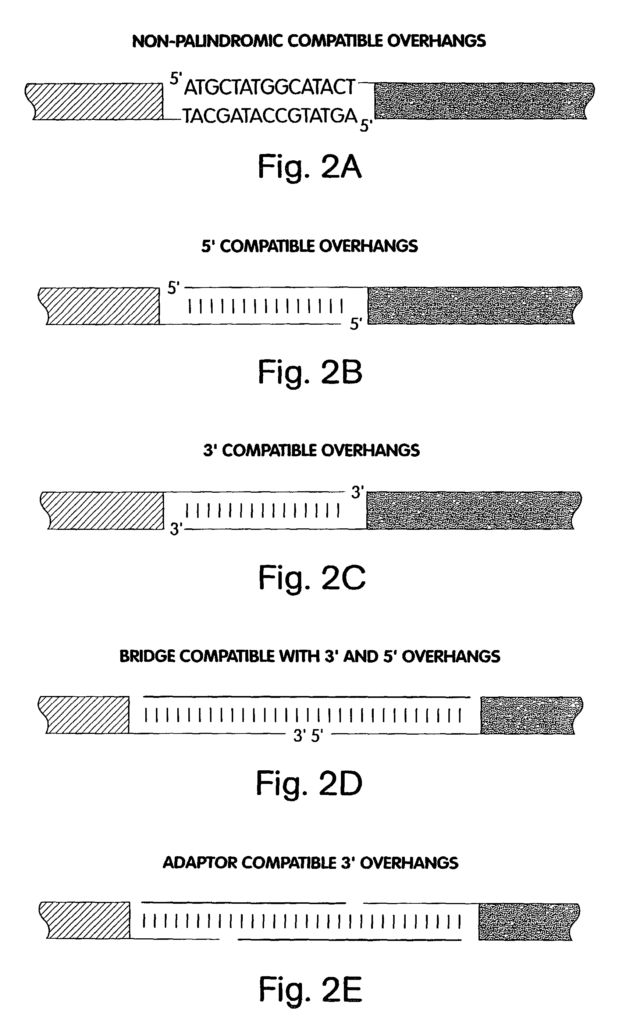
(a), providing the nucleic acids components and one of more linking nucleic acids molecules to be assembled into construct, where each nucleic molecule is a double-stranded nucleic molecule with at least one single-stranded 5? The terminal sequences of the nucleic acid components are 5? “terminal sequence” means a terminal sequence that is sufficiently complementary to the sequence of a linking nucleic acids molecule to allow specific annealing and linkage in a prescribed order.
The invention provides for “(b), incubating the components of nucleic acids under conditions that allow specific annealing, and linking the components to produce the multicomponent nucleic-acid construct.
The genetic element(s) can be single- or double-stranded. However, it is preferred that they are double-stranded.
In a preferred embodiment, the terminal sequences of the single-stranded nucleic acids are non-palindromic. The nucleic acids can be directly linked via annealing 5? The terminal sequences of 5? “Complementary terminal sequences, or indirectly through a linking nucleic-acid molecule” (e.g. “an oligonucleotide, or adaptor molecule.
The nucleic acids components can be connected either simultaneously or in a sequential manner to form a nucleic construct. Automating sequential assembly is possible. This method can be used for nucleic acids constructs that are functional when assembled, or constructs that are used as components in the assembly of functional constructs.
The invention allows for the synthesis of a group nucleic acids constructs where one or more components are substituted in each construct with another nucleic component that has the same utility or functionality. The method allows comparison between the components, and for the production of a construct that is optimal for a specific application. To achieve this, nucleic acids are synthesized and designed in a manner that allows a grouping of components to be categorized together (e.g. having the same functionality, etc.). A set of nucleic acids components encoding different promotors) have the same terminal sequences. This allows the same category of nucleic acids to be assembled into a multicomponent nucleic construct.
The nucleic acids components can also be modified covalently or not-covalently before or after assembly of the multicomponent nucleic construct. The synthesis of constructs with biological properties that are not easily obtained using current recombinant techniques is possible. The modification, for example, uses an arylboronic reagent such as phenyldiboronic acids.
The method is especially suitable for building nucleic acids vectors. They include plasmids, viral or phage-based vectors or yeast artificial chromosomes. The vector is a cloning vector or expression vector that can be used to express cDNA libraries or genomics, genes or fragments, mutant genes, recombined genes, or artificial genes. The constructs are suitable for prokaryotic and eukaryotic expression (mammalian, non-mammalian), construction of unique libraries, as well as protein, antibody, and peptide display libraries. The constructs are also useful for gene transfer, gene therapies, and creating transgenic organisms.
The vector can be assembled using nucleic acids that encode a single function or multiple functions. In certain applications, the invention allows for more than one biological functionality to be packaged into a single component of nucleic acids. It may be desirable to do this when, for instance, one wants to reduce the number of components that are assembled into the GEOS construct. In one embodiment, the nucleic acids encoding a replication origin, a selectable mark and an insert are used. Nucleic acids encoding vector functions can also be included depending on the desired type of vector (e.g. A promoter, transcription or translation regulatory elements, etc.) can be included in an expression vector. A gene expression vector can be created using nucleic acids encoding the structural gene of interest or a gene fragment and other nucleic acids encoding regulatory components required for gene expression. A cDNA library is created using nucleic acids that encode a collection cDNA molecules derived by poly(A+) mRNA. The optimization procedure described above, which involves interchanging nucleic acids components, can be used to produce an optimal vector.
The invention also provides a kit to produce vectors. In one embodiment, the kit would contain nucleic acids encoding origins for replication, selectable markers, and optionally transcriptional regulatory sequences. The kit may also include nucleic acids encoding vector functions other than replication origins (e.g. A promoter, transcription or translation regulatory elements, etc .).
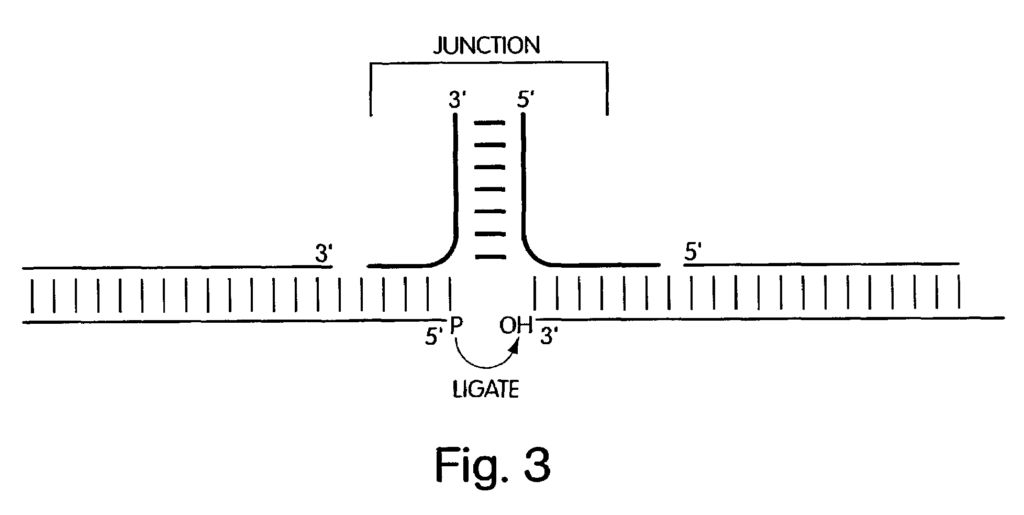
The invention also provides a kit to produce vectors. The kit would include at least nucleic acids encoding origins for replication, selectable marker and inserts. Kits could also contain nucleic acids coding for other vector functions, such as a promoter or transcription/translation regulatory element. A promoter, transcription or translation regulatory elements, etc .).
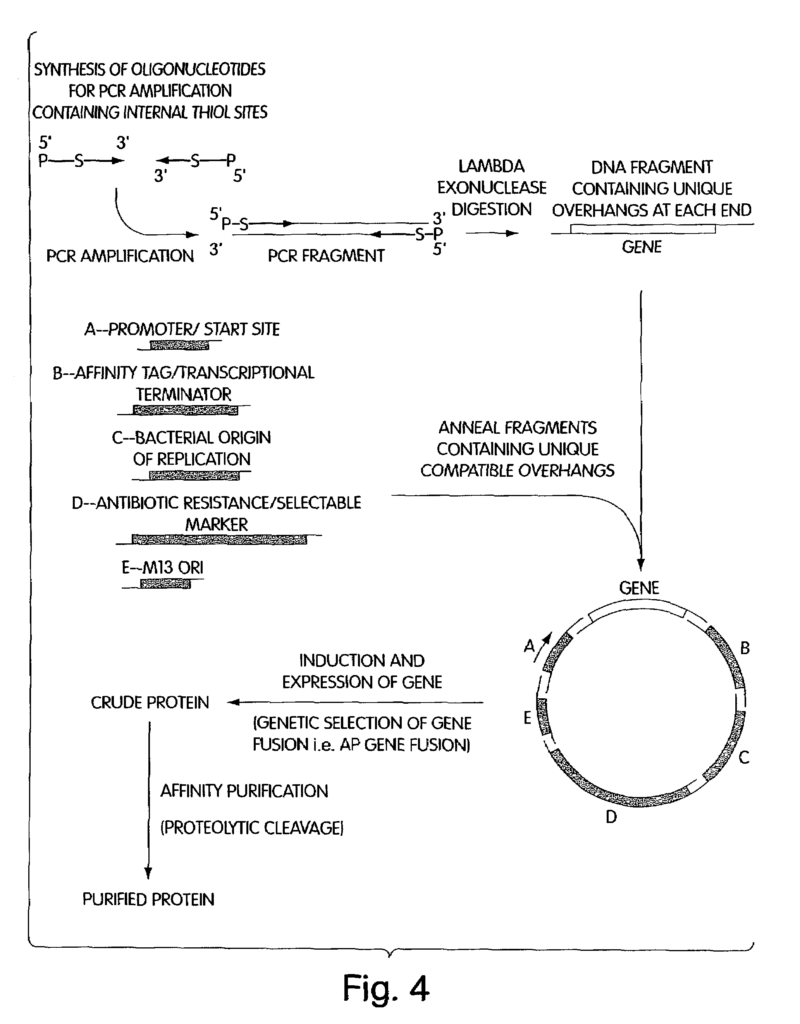
Click here to view the patent on Google Patents.
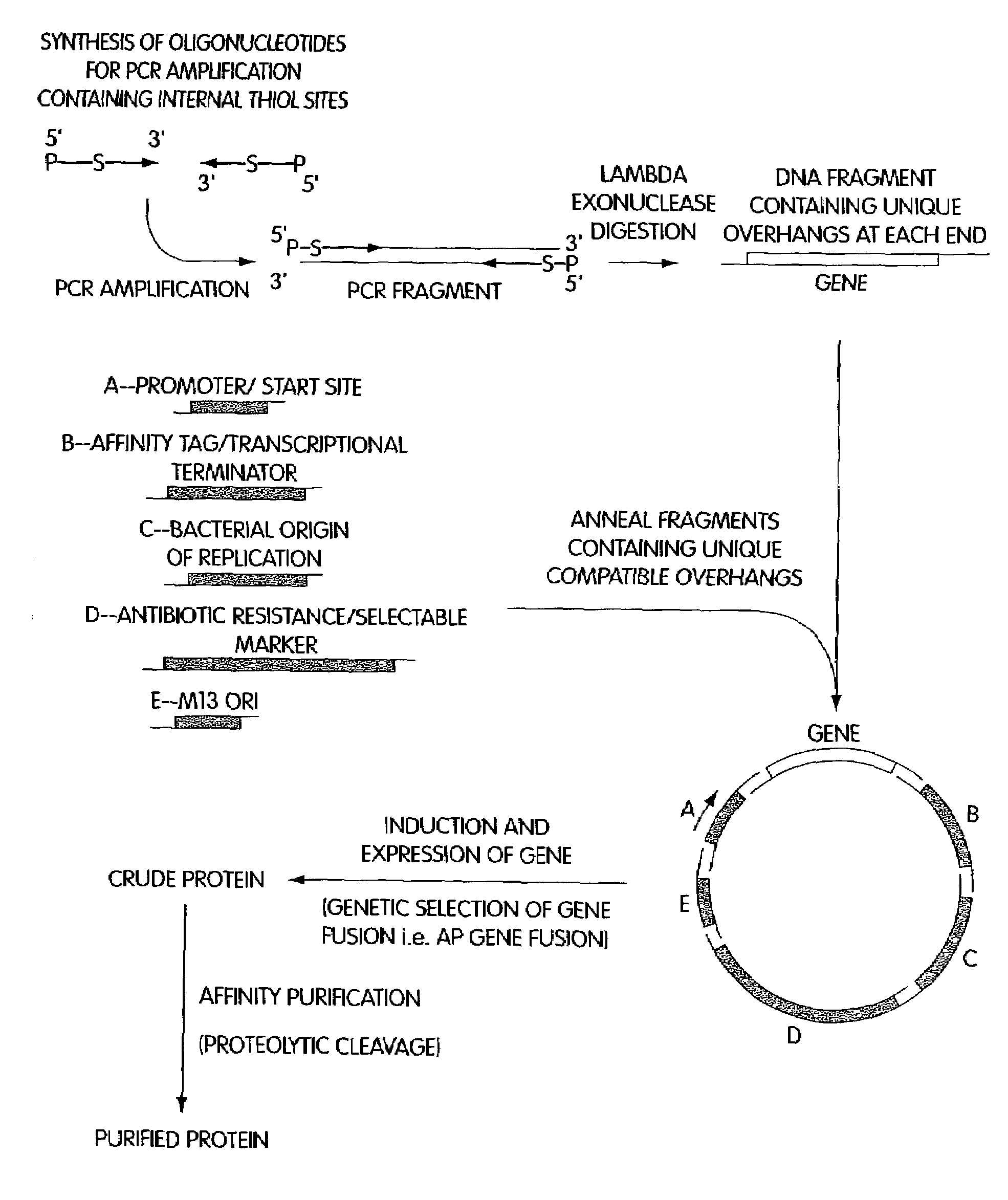
Leave a Reply